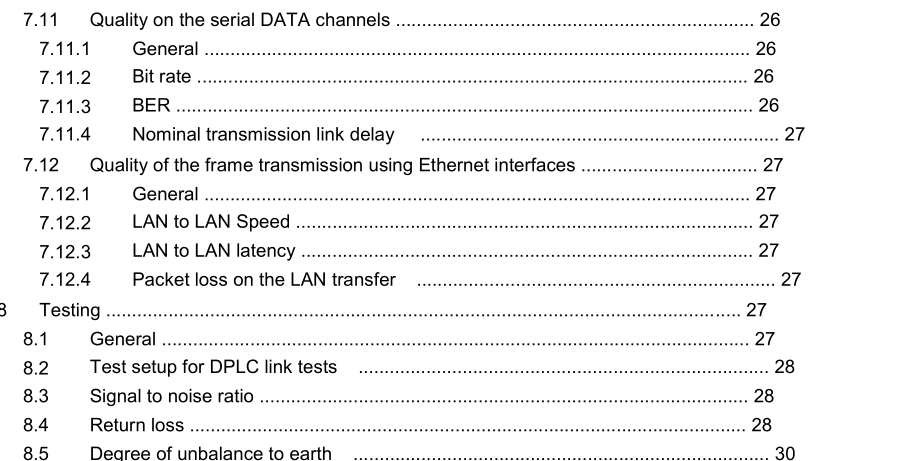IEC 62488-3-2021 pdf Power line communication systems for power utility applications – Part 3: Digital Power Line Carrier (DPLC) Terminals and hybrid ADPLC Terminals

4 Generic structure of DPLC and ADPLC terminals The generic structure describes the main building blocks of DPLC and ADPLC terminals. All other building blocks which are necessary for proper functioning (e.g. power supply, device control units) are not considered in Clause 4. Figure 2 shows the block diagram of a DPLC terminal with the digital and analog interfaces on the left side and the HF line interface on the right side. If only one interface is available, the function of the time division multiplexer / demultiplexer and optional Ethernet switch may be replaced by a simple direct connection to the digital PLC modem. The resulting pass band signal is amplified and matched to the coupling device using the power line interface.
Figure 3 shows the block diagram of an ADPLC terminal, which contains both a digital PLC modem as well as an analogue SSB modem, compliant with IEC 62488-2, that shall be used to convey signals coming from teleprotection or analogue I/O interfaces, with the digital and analogue interfaces on the left side and the HF line interface on the right side. An ADPLC terminal contains a digital PLC path, that was introduced above and shown in Figure 2, and may contain a teleprotection path and/or an APLC path according to IEC 62488-2. The output pass band signal of the digital PLC modem may be combined in the frequency domain with the output pass band signals of the optional teleprotection and/or APLC paths. The resulting pass band signal is amplified and matched to the coupling device using the power line interface.
For the physical characteristics (voltage, connector form factor, insulation, and pinout) of these interfaces, the relative reference standard shall be applied. An electrical Ethernet interface may optionally provide power over Ethernet of power level 1 or higher, according to IEEE 802.3. 5.2.1.3 Data link layer For this application the link layer should be compliant with the Ethernet standard IEEE 802.3. Normally for practical reasons more than one Ethernet port should be made available to implement switching functionalities for local network connection. Remote Ethernet connectivity may contain an implementation of the basic transparent WAN bridging functionalities, according to IEEE 802.1d.
- ISO IEC 27050-4-2021 pdf Information technology — Electronic discovery — Part 4: Technical readiness
- ISO IEC 27036-1-2021 pdf Cybersecurity — Supplier relationships — Part 1: Overview and concepts
- ISO IEC 27013-2021 pdf Information security, cybersecurity and privacy protection — Guidance on the integrated implementation of ISO/IEC 27001 and ISO/IEC 20000-1
- ISO IEC 26580-2021 pdf Software and systems engineering — Methods and tools for the feature- based approach to software and systems product line engineering
- ISO IEC 24735-2021 pdf Information technology — Office equipment — Method for measuring digital copying productivity
- ISO IEC 24711-2021 pdf Information technology — Office equipment — Method for the determination of ink cartridge yield for colour inkjet printers and multi- function devices that contain printer components
- ISO IEC 23544-2021 pdf Information Technology — Data centres — Application Platform Energy Effectiveness (APEE)
- ISO IEC 23510-2021 pdf Information technology — 3D printing and scanning — Framework for an Additive Manufacturing Service Platform (AMSP)
- ISO IEC 23127-1-2021 pdf Information technology — Learning, education, and training — Metadata for facilitators of online learning — Part 1: Framework
- ISO IEC 23126-2021 pdf Information technology for learning, education and training — Ubiquitous learning resource organization and description framework
- IEC 62858-2015 pdf Lightning density based on lightning location systems (LLS) – General principles
- IEC 60034-5-2006 pdf Rotating electrical machines – Part 5: Degrees of protection provided by the integral design of rotating electrical machines (IP code) – . Classification
- IEC TR 63226-2021 pdf Managing fire risk related to photovoltaic (PV) systems on buildings
- IEC 60426-2007 pdf Electrical insulating materials – Determination of electrolytic corrosion caused by insulating materials – Test methods
- IEC TS 62796-2013 pdf Energy efficiency in electroheating installations
- BS ISO IEC 15420-2009 pdf Information technology一 Automatic identification and data capture techniques EAN/UPC bar code symbology specification
- BS IEC 60860-2014 pdf Radiation protection instrumentation一 Warning equipment for criticality accidents
- BS ISO IEC 19762.5-2008 pdf Information technology一 Automatic identification and data capture (AIDC) techniques – Harmonized vocabulary Part 5: Locating systems
- ISO IEC 24735-2021 pdf Information technology — Office equipment — Method for measuring digital copying productivity
- ISO IEC 24711-2021 pdf Information technology — Office equipment — Method for the determination of ink cartridge yield for colour inkjet printers and multi- function devices that contain printer components